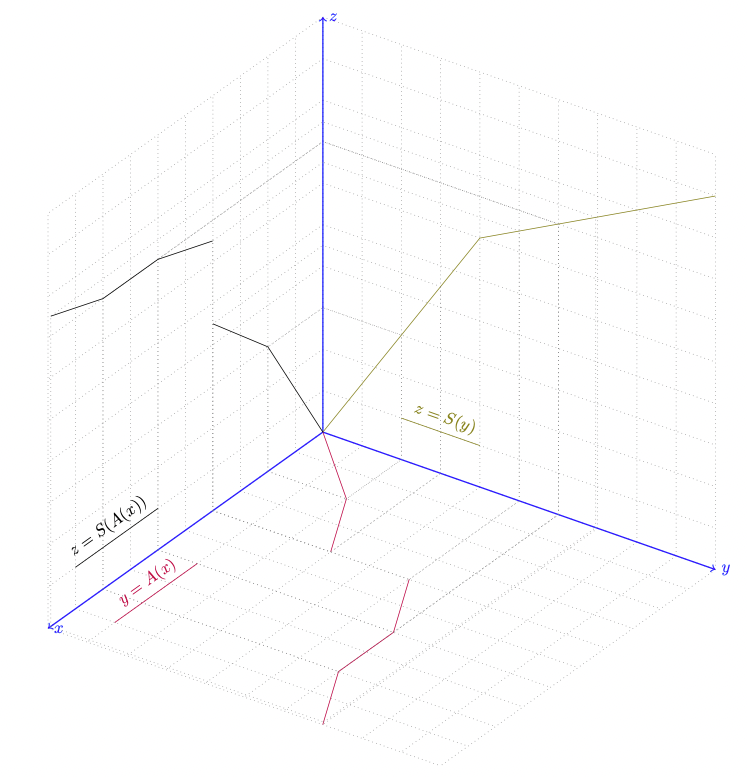This example draws the composition of two functions in a semi-automatic way, using 3d and intersections.
\documentclass[tikz,border=10pt]{standalone}
\usetikzlibrary{intersections}
\usepackage{tikz-3dplot}
\begin{document}
%%%%%%%%%%%%%%%%%%%%%%%%%%%%%%%%%%%%%%%%%%%%%%%%%%%%%%%%%%%%%%%%%%%%%%
%% This tikz-code allow to "draw" the composition of two functions.
%%
%% The principle is the following: one have to draw y=A(x) and z=S(y),
%% then, for each X, uses projections and intersections to define the
%% point (X,0,S(A(X)).
%%% This is the core command:
%%% It assumes
%%% - the function A is drawn on name path=A
%%% - the same for S
%%% - it exist paths Xaxis, Yaxis, Zaxis
% Parameters:
% #1: X
% #2: name of the point to store (X,0,S(A(X))
\newcommand{\drawDfromX}[2]{
% Set the source
\coordinate (X) at (#1,0,0);
% Goes from (x,0) to (x, A(x))
\path[name path=XtoA] (X) -- ++(0,10,0);
\draw[proj,name intersections={of=A and XtoA}] (X) --
(intersection-1) coordinate (AX);
% Goes to A(X) on Y axis
\path[name path=AtoY] (AX) -- ++(-10,0,0);
\draw[proj, name intersections={of=AtoY and Yaxis}] (AX) --
(intersection-1) coordinate (YfromX);
\path[name path=YtoS] (YfromX) -- ++(0,0,10);
% Goes from (0,y,0) to (0, y, S(y))
\draw[proj, name intersections={of=S and YtoS}] (YfromX) --
(intersection-1) coordinate (SY);
\path[name path=SYtoZ] (SY) -- ++(0,-10,0);
\draw[proj, name intersections={of=SYtoZ and Zaxis}] (SY) --
(intersection-1) coordinate (Z);
% Draw z=S(A(x))=D(x)
\path[name path=XtoD] (X) -- ++(0,0,10);
\path[name path=ZtoD] (Z) -- ++(10,0,0);
\path[name intersections={of= XtoD and ZtoD}] (intersection-1)
coordinate (D) -- (0,0);
\draw[proj] (X) -- (D) -- (Z);
\coordinate (#2) at (D);
}
\tdplotsetmaincoords{60}{125}
\begin{tikzpicture}[tdplot_main_coords,
cube/.style = {very thick, black},
% grid/.style = {very thin, gray},
grid/.style = {gray, dotted},
% proj/.style = {very thin, gray},
proj/.style = {gray, dotted},
axis/.style = {->, blue, thick}]
% Draw grids
\foreach \i in {0,...,10}
{
\draw[grid] (\i,0,0) -- (\i,10,0);
\draw[grid] (\i,0,0) -- (\i,0,10);
\draw[grid] (0,\i,0) -- (10,\i,0);
\draw[grid] (0,\i,0) -- (0,\i,10);
\draw[grid] (0,0,\i) -- (0,10,\i);
\draw[grid] (0,0,\i) -- (10,0,\i);
}
% Draw the axes
\draw[axis,name path=Xaxis] (0,0,0) -- (10,0,0) node[anchor=west]{$x$};
\draw[axis,name path=Yaxis] (0,0,0) -- (0,10,0) node[anchor=west]{$y$};
\draw[axis,name path=Zaxis] (0,0,0) -- (0,0,10) node[anchor=west]{$z$};
% Draw y=A(x)
\draw[purple, name path=A] (0,0,0) -- (2,2) -- (4,3)
(4,5) -- ++(2,1,0) -- ++(2,0,0) -- ++(2,1,0);
% Draw z = S(y)
\draw[olive,name path=S] (0,0,0) -- ++(0,4,6) -- ++(0,6,3);
% Compute D = S(A(x))
\drawDfromX{2}{D2}
\drawDfromX{4}{D4}
\drawDfromX{4.01}{D4+}
\drawDfromX{6}{D6}
\drawDfromX{8}{D8}
\drawDfromX{9.9}{D9}
% Plot D
\draw (0,0,0) -- (D2) -- (D4) (D4+) -- (D6) -- (D8) -- (D9);
% Legend
\draw[black] (9,0,1) -- ++(-3,0,0) node[above,pos=.5,sloped] {$z=S(A(x))$};
\draw[olive] (0,2,1) -- ++(0,2,0) node[above,pos=.5,sloped]
{$z=S(y)$};
\draw[purple] (9,1,0) -- ++(-3,0,0) node[above,pos=.5,sloped]
{$y=A(x)$};
\end{tikzpicture}
\end{document}


